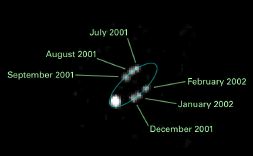

,
|
Документ взят из кэша поисковой машины. Адрес
оригинального документа
: http://www.stsci.edu/~inr/thisweek1/2008/thisweek301.html
Дата изменения: Thu Feb 21 19:54:10 2013 Дата индексирования: Sat Mar 1 12:34:17 2014 Кодировка: Поисковые слова: hydrogen |


,
HST resumed operations on the side B electronics on the CU/SDF (Command Unit/Science Data Formatter) on 23 October 2008. WFPC2 calibration measurements and on-sky observations restarted on October 25th, and the ACS/SBC will be brought on line later this week.
| Program Number | Principal Investigator | Program Title | Links |
| 11103 | Harald Ebeling, University of Hawaii | A Snapshot Survey of The Most Massive Clusters of Galaxies | Abstract |
| 11113 | Keith S. Noll, Space Telescope Science Institute | Binaries in the Kuiper Belt: Probes of Solar System Formation and Evolution | Abstract |
| 11130 | Luis Ho, Carnegie Institution of Washington | AGNs with Intermediate-mass Black Holes: Testing the Black Hole-Bulge Paradigm, Part II | Abstract |
| 11212 | Filling the Period Gap for Massive Binaries | Douglas R. Gies, Georgia State University Research Foundation | Abstract |
| 11213 | Gerard T. van Belle, California Institute of Technology | Distances to Eclipsing M Dwarf Binaries | Abstract |
| 11289 | Jean-Paul Kneib, Laboratoire d'Astronomie Spatiale | SL2S: The Strong Lensing Legacy Survey | Abstract |
| 11299 | Todd J. Henry, Georgia State University Research Foundation | Calibrating the Mass-Luminosity Relation at the End of the Main Sequence | Abstract |
| 11704 | Brian Chaboyer, Dartmouth College | The Ages of Globular Clusters and the Population II Distance Scale | Abstract |
| 11788 | George Fritz Benedict, University of Texas at Austin | The Architecture of Exoplanetary Systems | Abstract |
| 11901 | Filling the Period Gap for Massive Binaries | Douglas R. Gies, Georgia State University Research Foundation | Abstract |
| 11902 | Different responses in interacting galaxies | Mario Livio, Space Telescope Science Institute | Abstract |
GO 11113: Binaries in the Kuiper Belt: Probes of Solar System Formation and Evolution
 A composite of HST images of the Kuiper Belt binary, WW31
A composite of HST images of the Kuiper Belt binary, WW31
|
The Kuiper Belt consists of icy planetoids that orbit the Sun within a broad band stretching from Neptune's orbit (~30 AU) to distance sof ~50 AU from the Sun (see David Jewitt's Kuiper Belt page for details). Over 500 KBOs are currently known out of a population of perhaps 70,000 objects with diameters exceeding 100 km. Approximately 2% of the known KBOs are binary (including Pluto, one of the largest known KBOs, regardless of whether one considers it a planet or not). This is a surprisingly high fraction, given the difficulties involved in forming such systems and the relative ease with which they can be disrupted. It remains unclear whether these systems formed from single KBOs (through collisions or 3-body interactions) as the Kuiper Belt and the Solar System have evolved, or whether they represent the final tail of an initial (much larger) population of primordial binaries. This proposal will use WFPC2 imaging of known KBOs to identify new binary systems. |
GO 11213: Distances to Eclipsing M Dwarf Binaries
GO 11289: SL2S - The Strong Lensing Legacy Survey
GO 11704: The Ages of Globular Clusters and the Population II Distance Scale
 Hubble Heritage image of the globular cluster, M15
Hubble Heritage image of the globular cluster, M15
|
Globular clusters are the oldest structures within the Milky Way that are directly accessible to observation. They are relatively simple systems, with relatively simple colour-magnitude diagrams (albeit with some complexities adduced from recent HST observations, see GO 11233 ). Matching those CMDs against theoretical models allows us to set constraints on the age of the oldest stars in the Galaxy, and hence on the age of the Milky Way and the epoch of galaxy formation. However, the accuracy of those age determinations rest crucially on the accuracy of the cluster distance determinations. The clusters themselves lie at distances of several kpc at best, and tens of kpc at worst; thus, direct trigonometric parallax measurements must await microacrsecond astrometric missions. The classical method of deriving distances is main sequence fitting - using nearby stars, with similar chemical abundances and accurate parallax measurements, to map out the main sequence in absolute units, and then scaling the clusetr data to fit. The problem with this method is that metal-poor subdwarfs are rare, so even Hipparcos was only able to obtain accurate distances to a handful of stars. The present program aims to improve the distance measurements by using the Fine Guidance Sensors on HST to determine sub-millarcsecond trigonometric parallaxes to 9 subdwarfs, almost doubling the sample available for MS fitting. |